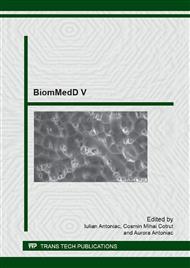[1]
E. Burzo, M. M. Codescu, W. Kappel, E. Helerea, Magnetic materials for technical applications, J. Optoelectron. Adv. Mater. 11 (2009) 229 - 237.
Google Scholar
[2]
G. Gnanaprakash, S. Mahadevan, T. Jayakumar, P. Kalyanasundaram, J. Philip, B. Raj, Effect of Digestion Time and Alkali Addition Rate on the Physical Properties of Magnetite Nanoparticles, Materials Chemistry and Physics 103 (2007) 168 - 175.
DOI: 10.1016/j.matchemphys.2007.02.011
Google Scholar
[3]
W. Luo, S.R. Nagel, T.F. Rosenbaum, R.E. Rosensweig, Dipole interactions with random anisotropy in a frozen ferrofluid, Phys. Rev. Lett. 67 (1991) 2721 - 2724.
DOI: 10.1103/physrevlett.67.2721
Google Scholar
[4]
K. Butter, P.H.H. Bomans, P.M. Frederik, G.J. Vroege, A.P. Philipse, Direct observation of dipolar chains in iron ferrofluids by cryogenic electron microscopy , Nat. Mater. 2 (2003) 88 - 91.
DOI: 10.1038/nmat811
Google Scholar
[5]
S. Yang, P. Zong, X. Ren, Q. Wang, X. Wang, Rapid and highly efficient preconcentration of Eu(III) by core-shell structured Fe3O4-Humic acid magnetic nanoparticles, ACS Applied Materials and Interfaces, 4, (2012) 6891-6900
DOI: 10.1021/am3020372
Google Scholar
[6]
S. Komarneni, W. Hu, Y. Dong Noh, A.Van Orden, S. Feng, C. Wei, H. Pang , F. Gao, Q. Lu, H. Katsuki, Magnetite syntheses from room temperature to 150 C with and without microwaves, Ceramics International 38, 2012, 2563–2568
DOI: 10.1016/j.ceramint.2011.11.027
Google Scholar
[7]
J. Jia, J.C. Yu, X.-M. Zhu, K. M. Chan, Y.-X. J. Wang , Ultra-fast method to synthesize mesoporous magnetite nanoclusters as highly sensitive magnetic resonance probe, Journal of Colloid and Interface Science 379 (2012) 1–7
DOI: 10.1016/j.jcis.2012.04.035
Google Scholar
[8]
M. Kawashita, K. Kawamura, Z. Li, PMMA-based bone cements containing magnetite particles for the hyperthermia of cancer, Acta Biomaterialia, 6 (2010) 3187–3192
DOI: 10.1016/j.actbio.2010.02.047
Google Scholar
[9]
T. Kikuchi, R. Kasuya, S. Endo, A. Nakamura, T. Takai, N. Metzler-Nolte, K. Tohji, J. Balachandran Preparation of magnetite aqueous dispersion for magnetic fluid hyperthermia, Journal of Magnetism and Magnetic Materials, 323 (2011) 1216–1222, Proceedings of 12th International Conference on Magnetic Fluid, Edited By H. Yamaguchi, S. Kamiyama and B. Jeyadevan
DOI: 10.1016/j.jmmm.2010.11.009
Google Scholar
[10]
M. Kawashita, M. Tanaka, T. Kokubo, Y. Inoue, T. Yao, S.Hamada, T. Shinjo, Preparation of ferrimagnetic magnetite microspheres for in situ hyperthermic treatment of cancer Biomaterials, 26 (2005) 2231-2238
DOI: 10.1016/j.biomaterials.2004.07.014
Google Scholar
[11]
M. Hasegawa, S . Hokkoku, US Patent No. 4,101,435, (1978).
Google Scholar
[12]
W. Xinchao, R.C. Viadero Jr., K.M. Buzby, Recovery of iron and aluminum from acid mine drainage by selective precipitation, Environ. Eng. Sci. 22 (2005) 745–755.
DOI: 10.1089/ees.2005.22.745
Google Scholar
[13]
T. Kawaguchi,T. Hanaichi, M. Hasegawa, S. Maruno, Dextran-magnetite complex: conformation of dextran chains and stability of solution, J. Mater. Sci. : Mater. Med. 12 (2001) 121-127.
Google Scholar
[14]
T. Kawaguchi, M. Hasegawa. Structure of dextran-magnetite complex: relation between conformation of dextran chains covering core and its molecular weight. J. Mater. Sci.: Mater. Med. 11 (2000) 31 - 5.
Google Scholar
[15]
M.A. Legodi, D. de Waal, The preparation of magnetite, goethite, hematite and maghemite of pigment quality from mill scale iron waste, Dyes and Pigments 74 (2007) 161-168.
DOI: 10.1016/j.dyepig.2006.01.038
Google Scholar
[16]
N. Pahimanolis, A-H. Vesterinen, J. Rich, J. Seppala, Modification of dextran using click-chemistry approach in aqueous media, Carbohydrate Polymers 82 (2010).78–82.
DOI: 10.1016/j.carbpol.2010.04.025
Google Scholar
[17]
Z. Xia, G. Wang, K. Tao, J. Li, Preparation of magnetite–dextran microspheres by ultrasonication Journal of Magnetism and Magnetic Materials, 293 (2005) 182-186
DOI: 10.1016/j.jmmm.2005.01.059
Google Scholar
[18]
J. Dinga, K. Tao, J. Li, S. Song, K. Sun, Cell-specific cytotoxicity of dextran-stabilized magnetite nanoparticles, Colloids and Surfaces B: Biointerfaces 79 (2010) 184–190
DOI: 10.1016/j.colsurfb.2010.03.053
Google Scholar


